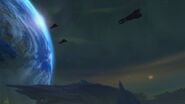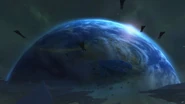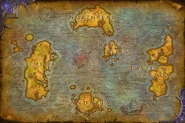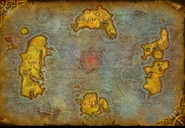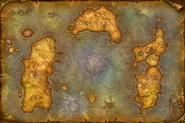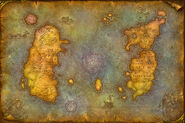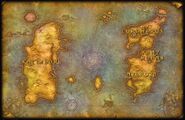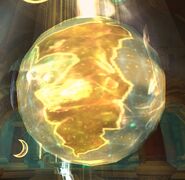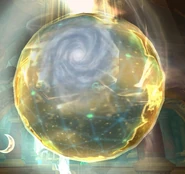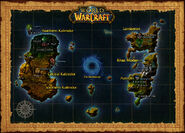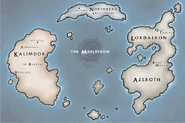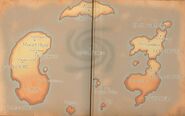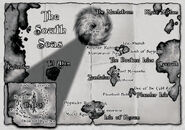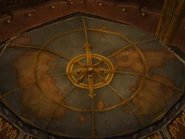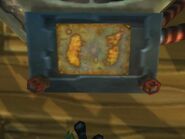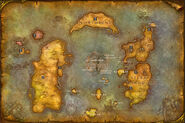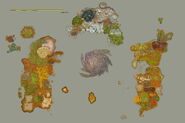| “ | Perhaps it is your imperfection that which grants you free will. That allows you to persevere against cosmically calculated odds. You prevailed where the Titans' own perfect creations have failed.
|
” |
- For other uses, see Azeroth.
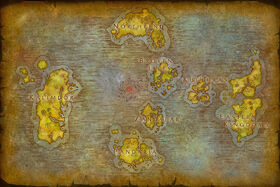
Map of Azeroth in Lua error in package.lua at line 80: module 'Module:Inlinegfx/img_link_data.json' not found. Patch 8.0.1
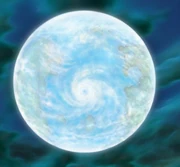
Azeroth as seen from the Black Temple.
Azeroth is the name of the world in which the majority of the Warcraft series is set. The world of Azeroth is the birthplace of many races, most notable being elves (night elves, high elves, and blood elves), humans, dwarves, tauren, goblins, trolls, gnomes, pandarens and dragons. At its birth, Azeroth was blessed by the titans. One day, the demonic armies of the Burning Legion came and shattered the peace and led the night elves to sunder their world. Gradually, races were dragged to Azeroth (such as the orcs, draenei, and ogres), others evolved, and others were brought up from the dust itself.
The peoples of Azeroth have fought brutally against the demons and their servants, and much blood was, and is still being, shed. After the Third War, three major powers emerged: the Scourge, Horde, and Alliance. Other major powers include the naga, qiraji, and Scarlet Crusade. Although ravaged by conflict, somehow through trickery, betrayal, and sheer blood, Azeroth has survived the Burning Legion four times. However, Azeroth is still torn by conflict, hate, and war.
Geographical features[]
Continents, Islands and Seas[]
Four continents are known to exist in modern times on Azeroth, one in each geographical direction from a central Maelstrom of magical energies: the Eastern Kingdoms to the east, Kalimdor to the west, Northrend to the north and Pandaria to the south.[1] The Eastern Kingdoms can further be divided into subcontinents, from north to south: Quel'Thalas (meaning "High Kingdom" in elven tongue), Lordaeron (which translates to "Land of Peaceful People", Khaz Modan ("Mountains of Khaz") and a subcontinent also named Azeroth.[2]
The sea surrounding the Maelstrom bears the name of Great Sea, while east of the Eastern Kingdoms lies the Forbidding Sea and west of Kalimdor is the Veiled Sea. The waters surrounding the south of the Eastern Kingdoms and Kalimdor are referred to as the South Seas.[1] No one is sure or has knowledge of what kind of creatures, lands, sentient beings and cultures may exist on the other side of the planet. "A handful of ships have ventured from Kalimdor [...] to the north, west, and south. None have yet returned."[3] Adventurers who have had the chance of observing projections of Azeroth from titan facilities state that the Veiled Sea and the Forbidding Sea merge uninterrupted on the other side of the Azeroth and that an ice cap covers the sea around the North Pole.[4]
Among Azeroth's largest islands are Kul Tiras west of central Eastern Kingdoms, Quel'Danas north of the former's northern edge, Zandalar north of Pandaria, Coldarra west of Northrend and the archipelago of the Broken Isles east of the Maelstrom.
Mountains and Lakes[]
Azeroth's tallest mountain ranges are the Alterac Mountains and Aerie Peak in Lordaeron, Dun Morogh in Khaz Modan, the Redridge Mountains in the Azeroth subcontinent, Mount Hyjal and Stonetalon Mountains in northern Kalimdor, the Storm Peaks in Northrend and Kun-Lai Summit in Pandaria.[5][2] The world's largest lakes are Lordamere Lake and Darrowmere Lake, both in Lordaeron. Another large lake, Loch Modan situated in Khaz Modan, was artificial in nature, but has dried up in recent years.[1]
Climate and Vegetation[]
The climate of the Eastern Kingdoms ranges from temperate in the north to tropical in the south. Kalimdor's northernmost islands indicate sub-polar climate and tropical climate can be observed in the south. Northrend lies within the polar and sub-polar latitudes of the planet and Pandaria within the tropical or sub-tropical latitudes. Khaz Modan's and Pandaria's mountains probably play a key role in cooling the weather in surrounding territories. Azeroth's temperate regions have a cycle of four seasons.
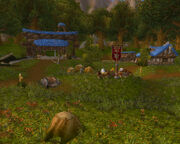
Azeroth has beautiful farmland.
The Eastern Kingdoms' landscapes are composed mainly of pine and broad-leaf forests in Lordaeron, tropical forests and wetlands in southern Azeroth, while the rest of the continent is dotted by forests, steppes and arid wastelands, some of the latter having magical origins. Northern Kalimdor is covered by pine and broad-leaf forests that give way to steppes and savannas towards the center of the continent. Arid and semi-arid deserts span in the south with a few patches of tropical forests. Northrend's southern edges are home to boreal forests, that give way to tundra and the polar desert as one advances northwards. Pandaria is home mainly to tropical forests.
Azeroth's Geography In the Past[]

Azeroth's star. Commonly called the sun.
The current shape of the continents came into existence 10,000 years ago. During Azeroth's prehistory a super-continent encompassed the landmasses known today. During that age medusa-like beings of pure evil known as the Old Gods arrived and ruled over Azeroth. The benevolent Titans ended their reign and the Titans' agents reshaped the relief and dredged out lakes and rivers, but left the shape and size of the super-continent roughly the same. This continent came to be known as ancient Kalimdor. Some regions on the edges of Kalimdor were also left untouched, since they were already home to the titan facilities of Ulduar in the north and Uldum in the southwest, while others were sites of the Old Gods' prisons, such as Ahn'Qiraj (southwest) and yet another, the Vale of Eternal Blossoms in the south, served as hideaway for one of the Old Gods' hearts.[6]
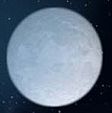
The moon known as White Lady.
Ancient Kalimdor's most prominent feature however must have been the Well of Eternity, the contient's largest lake situated in its center. It came into existence after the death of one of the Old Gods that had embedded itself into the land there. The lake's size wasn't the only thing special about it, since it contained the magical energies that erupted out of the world's core when the Old God was slain by a titan. Ages later, 10,000 years ago more exactly, the Well of Eternity was used for the summoning of a demon army. This eventually caused the portal and the well to explode and shatter the center of the ancient continent. Water rushed in to cover the sundered landmasses and give shape to the current shorelines. The whirling magical energies that remained in the place of the Well of Eternity are known today as the Maelstrom.[6] This vortex has been active since the sundering of Kalimdor and still there is no foreseeable natural end to its existence. It's believed that a part of the Well still exists in the rift at the bottom of the Maelstrom.
Azeroth has two moons, the White Lady, also known as Elune (in night elven language) and the Blue Child.
History[]
- Main article: Timeline
Primordial Age[]
After the birth of the cosmos and its planets, on many of them, including Azeroth, the first of their denizens came into existence - the Elemental spirits. During this age the spirits, ruled by the Elemental Lords, reigned over the world and fought each other for territory and influence in a never-ending chaotic conflict.[6]
Age of the Old Gods[]
Eventually the Old Gods landed on the planet and began their work on corrupting it. Out of their bodies two new species were created, the Aqir and the N'raqi, tasked with constructing city-fortresses to protect the Old Gods and fighting anyone who would oppose them. Seeing this new threat, the Elemental Lords banded together for the first time in history and tried to combat the new invaders. However the vast hordes of Aqir and N'raqi would prove too much for the Elementals and they found themselves enslaved to the monstrous Old Gods' will. For much of Azeroth's prehistory, the Old Gods would rule over the world along with their Elemental Lieutenants.
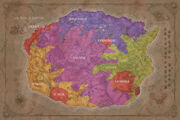
Azeroth's ancient super-continent under the thrall of the Black Empire of the Old Gods and their Elemental slaves.
Deep within Azeroth's core lies a world-soul, a nascent, sleeping Titan that, when awakened, could become extremely powerful. Sometime about 147,000 years ago the echoing dreams of this world-soul reached the Titan Aggramar, who then traveled with the rest of the Titan Pantheon to Azeroth. Seeing the corruption of the Old Gods, they decided to fight them in a global war. With the help of their golem-like constructs (the ancestors of dwarves, gnomes, vrykul, and giants), they defeated the aqir and n'raqi armies. Still the Old Gods themselves managed to repel the constructs. Then the Titan Aman'Thul reached down and forcefully ripped the Old God Y'Shaarj from the crust of the planet. Due to the titan's sheer size and the Old God's magic this act created a fathomless crater and a vortex of whirling energies. Seeing this dangerous scar on Azeroth and the world-soul, the titans decided to imprison the remaining three Old Gods instead in underground vaults.[6][7]
Age of the Ordering[]
In an attempt to mend the scar as best as they could, the constructs molded it into a lake of potent magical energies and named it the Well of Eternity. Then the constructs set out to reshape the rest of the world into a habitable place for the myriad of species they would later create. All this was meant to help the nascent titan within the planet to grow and evolve. When their work was finished, the constructs named the main continent Kalimdor: "Land of Eternal Starlight". This process, that lasted until about 65,000 BDP, is known as the Ordering.[7]
Not long after the reshaping of the planet was finished, a species of brilliant creatures caught the attention of the Constructs' leaders. These were the proto-dragons and they have just vanquished a great danger to Azeroth, in a time when the constructs themselves grew weary and isolationist. Recognizing the dragons' potential for protecting the world, the constructs blessed them with the titans' power and charged the five strongest of them to become the Dragon Aspects.[6]
Post Ordering Age[]
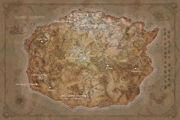
Kalimdor after the Titans sealed the Old Gods in their prisons.
The trolls are presumed to be Azeroth's first sentient race that emerged from the Ordering, not including the titan constructs who would later suffer the Curse of Flesh. From Zandalar, they spread across Kalimdor and formed great empires, most notably the Gurubashi and Amani. Later, the surviving aqir rose into an empire in the west, Azj'Aqir, forcing the trolls to better defend their major holdings. With pressure from their trollish enemies, the empire of the aqir collapsed and split into the qiraji and the nerubian kingdoms.
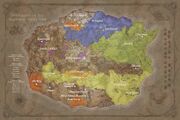
Aftermath Of The Aqir And Troll War
Around this time, the elves appeared in Kalimdor. Using the potent magics of the Well of Eternity (a legacy of the titan—old god war), the elves broke troll influence in many regions and established a magocratic empire. At the peak of kaldorei power, however, 10,000 years ago the Burning Legion invaded Azeroth, inciting the War of the Ancients also known as the first invasion of the Burning Legion. The night elves and their allies were forced to destroy the Well, which caused a sundering that split the ancient super-continent of Kalimdor apart — leaving several continents in its aftermath: Northrend, the Eastern Kingdoms, Kalimdor, and Pandaria.
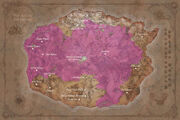
The Night Elven empire at its greatest extent.
Just before the Great Sundering, the last pandaren Emperor was made aware of the impending disaster and found a way to protect Pandaria from the destruction. He made a pact with unknown forces to shroud his land within an impenetrable mist for ten thousand years.[8]
Post Sundering Age[]
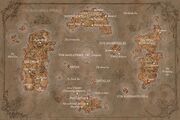
The remains of Kalimdor immediately after The Sundering.
Following the war there was a schism among the elves. The night elves started practicing druidism with Malfurion Stormrage as the first Night Elf Druid; the high elves however, former upper-class citizens (Quel'dorei in the elven tongue), refused to give up arcane magic. About 7,000 years ago, these high elves were banished from Kalimdor and settled in the north of Lordaeron, establishing the mighty kingdom of Quel'Thalas. The Amani Empire was still a strong force here, and the two cultures soon clashed in what became known as the Troll Wars. With support from the young race of humanity, the high elves broke and scattered what remained of the Amani empire.
The First and Second War[]
Lua error in package.lua at line 80: module 'Module:Inlinegfx/img_link_data.json' not found.
Lua error in package.lua at line 80: module 'Module:Inlinegfx/img_link_data.json' not found.
- Main article: First War
- Main article: Second War
Thousands of years later, and about 40 years before current events, the Burning Legion attempted to destroy Azeroth once more, this time indirectly. Sargeras, the lord of the Legion, manipulated the once peaceful orcs from the world called Draenor and their allies, the ogres to invade Azeroth, more exactly the Eastern Kingdoms.[9] The extended conflict with these alien armies became known in lore as the First and Second Wars, during which time the Horde established their presence in the Black Morass, at Blackrock Mountain, in Alterac Valley, in the former dwarven city of Grim Batol, on the shore of the Wetlands and possibly on the island of Zul'Dare.[10][11] The mighty Horde was defeated by an alliance of high elves, dwarves, and humans. Feeling the effects of their demonic bloodrage dissipate as they languished in internment camps, the orcs were able to remember their peaceful, shamanic roots. Sensing this change, Thrall of the Frostwolf clan set about establishing a new Horde.
The Third War. 2nd invasion of the Legion[]
Lua error in package.lua at line 80: module 'Module:Inlinegfx/img_link_data.json' not found.
- Main article: Third War
Angered by the Horde's failure, the Burning Legion prepared for yet another invasion, the culmination of their efforts, on both continents. In the east, the Legion's Lich King pawn set loose a plague of undeath on the human kingdom of Lordaeron that the Legion so despised. This undead Scourge quickly crippled the northern powers, demoralizing the people of the Eastern Kingdoms in preparation for a Legion offensive. Lured to north by the Lich King, Prince Arthas of Lordaeron became his death knight pawn and the instrument of his liberation from the Legion's grasp. The Scourge under Arthas scattered the Knights of the Silver Hand, obliterated Lordaeron and broke the power of the Sunwell in Quel'Thalas.
In the West, the demons and their satyr allies made a more direct assault on their old kaldorei enemies. In desperation, the elves turned to Illidan, a demon hunter from the War of the Ancients who had violated druidic law and had been imprisoned for ten thousand years. During the course of the conflict, Illidan was persuaded by the insidious Arthas to attack the demon known as Tichondrius and drink from the Skull of Gul'dan (a small part in the Lich King's greater scheme to emancipate himself from his Legion jailers). Through the machinations of Medivh, Last Guardian of Tirisfal, leaders of the New Horde and the Alliance were drawn to Kalimdor. There they joined with the night elves to thwart the Legion advance into Hyjal, where the World Tree was vulnerable to demonic attack. While in Kalimdor, Thrall's people forged powerful alliances with the native tauren and the Darkspear exiles.
Concerned with the separatist Scourge, Kil'jaeden solicited the half-demonic Illidan into destroying the source of the Lich King's power. With the aid of his naga allies, who he had recalled from the Maelstrom, he succeeded in breaking at least some of the Lich King's power. Hounded by his night elf jailers and the seething blood elves, Illidan was unable to complete his task. Suffering under the effects of magical withdrawal, the blood elves were persuaded to enter into the ranks of the Illidari. With their help, Illidan toppled the regime of Magtheridon to become the new ruler of Outland.
The weakening of the Frozen Throne allowed some of the Scourge to regain their free will. Under the Banshee Queen Sylvanas Windrunner, these Forsaken managed to force the Legion-controlled undead from the ruins of Lordaeron and establish a stronghold beneath its streets. Arthas, meanwhile, fought a desperate battle in Northrend to save his master from the newly empowered lord of Outland, who under increasing threats from Kil'jaeden had taken up his quest to destroy the Lich King once more. Illidan failed and retreated to Outland, and Arthas was merged with the malicious spirit of the Lich King.
Two main factions and opposition to the Scourge[]
Lua error in package.lua at line 80: module 'Module:Inlinegfx/img_link_data.json' not found.
Following the Third War, the political landscape of Azeroth changed greatly. The night elves joined the Alliance, and the Forsaken joined the New Horde. The remaining citizens of Lordaeron, broken by the Scourge, formed new regimes: the xenophobic and zealous Scarlet Crusade and the compassionate Argent Dawn. The orcish nation of Durotar was established in Kalimdor, while the humans gathered into the colony of Theramore west of Dustwallow Marsh. With the armies of the Horde and the Alliance decimated by the Third War, or occupied with the new conflict in Outland, the defense of their borders became the responsibility of small bands of heroes and adventurers.
War in Outland[]
Lua error in package.lua at line 80: module 'Module:Inlinegfx/img_link_data.json' not found.
- Main article: War in Outland
After major threats in Silithus were neutralized by Horde and Alliance forces in the Qiraji War-Effort, the power-blocs once more formed a tentative alliance in response to the opening of the Dark Portal. The Horde formed an alliance of necessity with the blood elves, while the Alliance warily welcomed the draenei exiles into their ranks. The War in Outland was fought on multiple fronts and against numerous factions. The greatest threat was the Burning Legion, who, after their defeat on Hyjal were mobilizing their forces for yet another invasion of Azeroth, this time via Draenor. Illidan's hegemony in Outland proved short-lived.
After losing the support of Kael'thas Sunstrider, whose addiction to fel energy led him to side with the Legion, the scattered coalition of nagas, fel orcs, and demons called the Illidari were defeated by Sha'tari and Azerothian forces. After the destruction of the Illidari and his own defeat, Kael'thas returned to Azeroth, where had restored his beloved Sunwell as a means of summoning his new master, Legionlord Kil'jaeden into the material world. To counter this, the opposing factions in Shattrath, the Aldor and Scryers, joined with the Blood Knights of Quel'Thalas. This Shattered Sun Offensive succeeded in disrupting the Legionlord's entry into Azeroth.
The War Against the Lich King[]
Lua error in package.lua at line 80: module 'Module:Inlinegfx/img_link_data.json' not found.
- Main article: War against the Lich King
After defending their major holdings from a Scourge incursion in Kalimdor and Azeroth, the Horde-Alliance blocs, emboldened by their conquest of Outland, launched a final joint offensive on the Scourge forces in Northrend. Their efforts have been bolstered thanks to yet another internal rebellion against the Scourge by the Knights of the Ebon Blade. The Horde-Alliance entente ended with the crisis at the Wrathgate. The joint forces were routed at the gates to Icecrown when a separatist faction of Forsaken bombarded the living and dead alike with their new strain of blight.
At war once again, Alliance and Horde heroes now compete for glory throughout the northern lands: aiding the Kirin Tor of Dalaran in their fight against the blue dragonflight, protecting the Frostborn dwarves and giants from the corrupted Titanic Keepers of Ulduar, and joining the Argent Crusade in the final push against the Lich King and the Scourge.
The Shattering and Recovery[]
Lua error in package.lua at line 80: module 'Module:Inlinegfx/img_link_data.json' not found.
- Main article: Shattering
- Main article: Elemental War
Meanwhile, deep within Deepholm, the domain of earth in the Elemental Plane, the corrupted Dragon Aspect Deathwing waited, recovering from the wounds of his last battle against Azeroth and biding his time until he tries again to reforge the world in molten fire. His eruption from Deepholm massively damaged the world. The kingdoms of Azeroth witnessed seismic shifts in power, the kindling of a war of the elements, and the emergence of unlikely heroes who rose up to protect their scarred and broken world from utter devastation.
Pandaria Revealed[]
Lua error in package.lua at line 80: module 'Module:Inlinegfx/img_link_data.json' not found.
- Main article: Alliance–Horde War (Mists)
After the destruction of Deathwing, the two superpowers of Azeroth — like restless siblings — the Alliance and the Horde have renewed their conflict for the land and resources of the planet. Mysteriously, the previously impenetrable mists covering the hidden continent of Pandaria have cleared and both factions now attempt to make allies and extend their reach to this newly discovered continent. Unfortunately, amidst their squabbling they have stirred a new menace that is powered by their aggression. Essence of the Old God, Y'Shaarj, populate the entire continent in the form of dangerous entities known as the Sha. A power hungry Garrosh Hellscream eventually finds the Old God's heart and uses it to empower himself and his True Horde. A coalition of forces from the Alliance and Horde are able to defeat Garrosh and kill the last bits of Y'Shaarj once and for all.
Peace wouldn't last long, the Black Prince frees Garrosh Hellscream and sends him to an alternate timeline on Draenor. There, Garrosh stops the Orc Clans from drinking the Blood of Mannoroth and helps his father Grommash Hellscream create the Iron Horde. Back on Azeroth, the Dark Portal opens up and the Iron Horde begins it's invasion. A small group of Horde and Alliance, led by Khadgar, are able to push back the Iron Horde to alternate Draenor and establish some garrisons. After a series of defeats for the Iron Horde, Gul'dan takes over leadership of the Iron Horde and reforms it into a parallel version of the Fel Horde. Heroes then battle their way through Hellfire Citadel, Gul'Dan's base of operations, and eventually encounter Archimonde. The demon lord is defeated and uses his last moments to send alternate Gul'Dan to Azeroth to make preparations for a Legion invasion.
Third Invasion of the Burning Legion[]
Lua error in package.lua at line 80: module 'Module:Inlinegfx/img_link_data.json' not found.
- Main article: Third invasion of the Burning Legion
Back on Azeroth, Gul'dan makes his way to the Broken Isles and, with the help of Kil'jaeden, opens up a portal to allow the Legion into Azeroth. Demons descend on the world and spearhead one of the largest Legion invasions Azeroth has ever known. Suramar, the mageocratic city state of the Nightborne elves, allies itself with the Burning Legion. In response to the Legion's attack, the Alliance and Horde send many troops to the Broken Shore to close up the portal and stop the invasion. The battle goes poorly and both faction leaders (Vol'jin of the Horde and Varian Wrynn of the Alliance) are killed. Dalaran is teleported to the Broken Isles and the Horde and Alliance regroup. After series of long battles on the isles, the Pillars of Creation are gathered and a renegade group of Nightborne help the factions assault Suramar. Elisande and alternate Gul'dan are killed, Illidan Stormrage is revived, and the forces turn to the Burning Legion forward base on the Broken Shore. In the Tomb of Sargeras, Velen, Khadgar, Illidan Stormrage, and a group of adventurers pursue Kil'jaeden to his ship over the demon world of Argus. Kil'jaeden is slain and Illidan opens up a large portal between Argus and Azeroth. Using a ship known as the Vindicaar, the forces of Azeroth meet up with the Army of the Light and lay siege to Argus. Sargeras makes his way to Azeroth while the Army of the Light frees the Titan pantheon and slays the corrupted world-soul of Argus. Using the power released from Argus's world soul, the Titan Pantheon imprisons the dark Titan Sargeras as he descends onto Azeroth. In a last ditch effort, Sargeras plunges his massive sword into the planet. With the Burning Legion taken care of, the heroes return to Azeroth to assess the damage.
Continuation of the Alliance–Horde War[]
Lua error in package.lua at line 80: module 'Module:Inlinegfx/img_link_data.json' not found.
After the final defeat of the Burning Legion and Sargeras, the two main factions enjoy a brief peace. The damage from Sargeras's final attack is extensive and the life blood of the world-soul seeps onto the surface and becomes known as Azerite. It doesn't take long for the factions to decide to harvest it for their own war efforts against each other. The Horde is the first to harvest this new powerful resource, while the Alliance follows close behind. Sylvanas Windrunner decides to initiate a preemptive strike and burns down the world tree of Teldrassil. In response to the attack, King Anduin Wyrnn leads an Alliance force to retake Lordaeron. In a last ditch defense effort Sylvanas floods Lordaeron City with toxic blight and escapes capture. With the war reaching a stalemate, both factions seek to bolster their armies. Jaina Proudmoore, the prodigal daughter of Kul Tiras has decided to renew her ties with her isolationist homeland to try to persuade them to lend the might of their navy against the Horde. In parallel, the leaders of the Horde are seeking the aid of the also powerful fleet of the trolls of the Zandalari islands to even the odds.
Native sapient races[]
Resident aliens[]
- Draenei refugees, originally from Argus, fleeing from Draenor/Outland have formed an enclave in the Azuremyst Isles.
- A large ogre population from Draenor is present as a result of the Second War.
- The orcs, also from Draenor, have established their own nation, Durotar, in Central Kalimdor.
- Large numbers of worgen are also present on Azeroth. They originated from the Druids of the Scythe using the forbidden Pack Form during the War of the Ancients, but were subsequently banished to the Emerald Dream by Malfurion Stormrage. Through the use of magical experimentation by Archmage Arugal and the Scythe of Elune by Velinde Starsong, the Worgen have made their way back into Azeroth and spread their curse around. Most notably, the once Human nation of Gilneas has been afflicted with the Worgen curse.
- Demons are also a prominent non-native species. Most have either been summoned by warlocks, came here during the Third War, and stayed, or arrived during subsequent demonic invasions.
- A few ethereals have ventured to Azeroth from Outland. Most of them can be found in the Magisters' Terrance and Karazhan. As demand for their services as risen, they have appeared in small numbers in various larger cities, Northrend, and Pandaria.
- Although they were among the first denizens in Azeroth, the Old Gods were created by the Void lords and sent to Azeroth in a bid to corrupt world-soul of the developing titan within.
- Insectoid species such as the Silithids, Nerubians, and Mantids as well as the tentacled N'raqi may also be considered resident aliens having been originally spawned from the biomass of the extraterrestrial Old Gods.
Proto-titan[]
Recent reports from a recently recovered Magni Bronzebeard indicate that Azeroth is a world-soul[12] which is a nascent titan in some early form of development.[13]
Origin of the name[]
Strangely, the term was in use during the War of the Ancients[14] by the night elves, which raises further questions about its etymology and origins. As confirmed, it apparently was from a dialect of Common (adapted from the term Azotha), but why the night elves would use it is unclear.
In the RPG[]
Lua error in package.lua at line 80: module 'Module:Inlinegfx/img_link_data.json' not found.
The term Azeroth is a human word and is derived from the term used for the ancient primitive-humans that lived on the world pre-sundering, the Azotha.[15]
It is said that when the Arathi brought the scattered human tribes together as the empire of Arathor, they named the land as a whole in homage to their ancient ancestors: Azeroth.[15] It is unclear whether they named the world or named the continent.
Speculation on the name origin[]
- The use of the word in the War of the Ancients trilogy could be considered a continuity error, although other sources imply that the world was called Azeroth at the time as well.
- It is a possibility that Azeroth being named after the Azotha and possibly the Azotha themselves are simply not considered canon lore by Chris Metzen, like Finall Goldensword, as they are not referenced outside of the RPG.
- It is possible that the night elves did not use the term Azeroth, and that - for the benefit of the reader - the night elf word was translated in the novel and is not a continuity error.
- Hazeroth is one of the locations that the Israelites stopped at during their forty years of wandering in the wilderness. It is referenced in the Torah in Numbers, chapters 11, 12 and 33, as well as in Deuteronomy, chapter 1.
Travel[]
- A peculiar feature of travel between continents on Azeroth is the tendency for major routes to use the air and water routes traveling east to the Eastern Kingdoms or back west even though all these routes must pass by the Maelstrom. For some reason, very few routes exist across the Forbidding Sea between the west coast of Kalimdor and the east coast of the Eastern Kingdoms. This might be explainable due to the eastern coasts of the Eastern Kingdoms being fairly rugged and mountainous with few major settlements, but the western coasts of Kalimdor seem mostly accessible. Also, the expanse of the Forbidding Sea could be up to twice that of the waters between the continents on the Maelstrom side. Perhaps, despite the lack of the Maelstrom, the waters of the Forbidding Sea are a bit too vast, less charted, and more harsh. Despite the troll town in Eastern Hinterlands and the Zoram Strand being an ideal Horde route from eastern Lordearon, the most likely reason would be that Blizzard has other plans, or just doesn't feel that the Forbidding Sea is that they've established more travel on the Great Seas as it is, and there may be sailors in lore who sail, but the PCs are more prone to travel across the Great Sea. Until some intrepid sailors collect their reports, we may never know.
- Observing 3D renderings of the planet in Ulduar and other places it seems that Kalimdor and Eastern Kingdoms are directly opposite each other (if you go directly through the planet). If you sail East from Eastern Kingdoms and West from Kalimdor there would be vast empty ocean, and if you believe that sort of thing, possibly more continents.
World models[]
In World of Warcraft, globes scattered around the game show what looks to be a sea with only a few islands dotting the surface opposite of the main continents. In the latest model of Azeroth, you are able to see a north polar ice cap. This may suggest that there is a south polar ice cap. In the model, the western edge of Kalimdor looks to be near enough to the eastern edge of the Eastern Kingdoms to suggest that there is not enough room for a big landmass in between them; although there could be islands of various sizes. Kalimdor and the Eastern Kingdoms may actually be opposite of each other on Azeroth.
The Forbidding Sea may blend into the Veiled Sea and vice versa. Spinning images of the world also appear in the introduction cinematics in the game's title. It should be noted however, that as with real world history these globes may only represent the known world, and the fact that Azeroth's inhabitants know the world to be a sphere, not necessarily the entire world.
Media[]
Images[]
Maps of Azeroth[]
Fan art[]
Video[]
Trivia[]
- The word "Azeroth" appeared in the title of a book by sci-fi author C. J. Cherryh named Fires of Azeroth published in 1979 which is the third of the The Morgaine Stories tetralogy. In this book, Azeroth is a world also ironically reached through a portal.
- A name similar "Azeroth" was found first in another fantasy world entirely. Azaroth was the name of a lesser god mentioned in the third chapter of The Horse and His Boy published in 1954 by C. S. Lewis.
References[]
- ^ a b c Metzen, Chris et al. World of Warcraft: Chronicle Volume 1, 108-109.
- ^ a b Warcraft III Manual, 64-74.
- ^ Warcraft: The Roleplaying Game, pg. 213
- ^ World of Warcraft: Wrath of the Lich King
- ^ Warcraft II Manual, 33.
- ^ a b c d e Metzen, Chris et al. World of Warcraft: Chronicle Volume 1, 19, 28-47, 105.
- ^ a b Baxter, Robert et al. Lands of Conflict, 30-36.
- ^ Meet the Pandaren. Official Mists of Pandaria site (US). Retrieved on 2012-08-13.
Meet the Pandaren. Official Mists of Pandaria site (EU). Retrieved on 2012-08-13. - ^ Golden, Christie. "?", Rise of the Horde, ?. ISBN 978-0-7434-7138-1. “?”
- ^ Metzen, Chris et al. World of Warcraft: Chronicle Volume 2, 116, 138, 151, 155.
- ^ Warcraft II: Tides of Darkness
- ^ World of Warcraft: Chronicle Volume 1, pg. 30
- ^ The Diamond King
- ^ The Sundering, pg. ??
- ^ a b Lands of Conflict, pg. 18
External links[]
- Lore
| |||||||||||||||||
| ||||||||||||||
